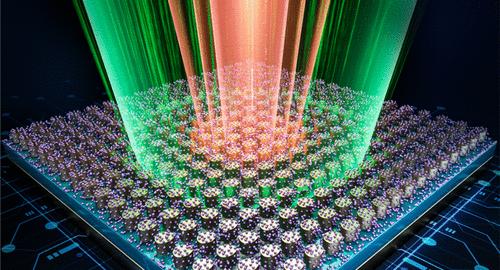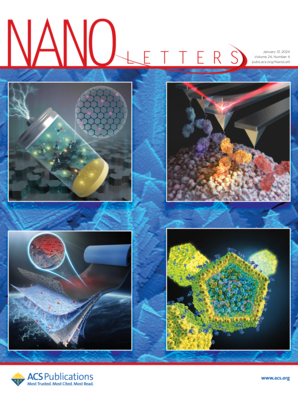Topologically Engineered High-Q Quasi-BIC Metasurfaces for Enhanced Near-Infrared Emission in PbS Quantum Dots
IF 9.6
1区 材料科学
Q1 CHEMISTRY, MULTIDISCIPLINARY
引用次数: 0
Abstract
Enhancing photoluminescence (PL) efficiency in colloidal quantum dots is pivotal for next-generation near-infrared photodetectors, imaging systems, and photonic devices. Conventional methods, especially metal-based plasmonic structures, suffer from large optical losses, which limits their practical use. Here, we introduce a quasi-bound state in the continuum (quasi-BIC) metasurface on a silicon-on-insulator platform, tailored to provide high-quality factor resonances with minimized losses. Utilizing topological charge engineering and controlled in-plane asymmetry in silicon cylinder arrays, we developed a robust quasi-BIC capable of maintaining a high Q factor across a broad angular range, achieving an experimental Q factor of 3031 at normal incidence. This approach significantly enhances near-field interactions, achieving a ≤110-fold increase in PL for PbS quantum dots at 33 K and a 41-fold enhancement at room temperature. Our findings offer a scalable, cost-effective solution for enhancing light emission in advanced optoelectronic applications.

用于增强PbS量子点近红外发射的拓扑工程高q准bic超表面
提高胶体量子点的光致发光(PL)效率是下一代近红外光电探测器、成像系统和光子器件的关键。传统的方法,特别是金属基等离子体结构,存在较大的光学损耗,这限制了它们的实际应用。在这里,我们在绝缘体上硅平台上的连续介质(准bic)超表面中引入了准束缚态,以提供具有最小损耗的高质量因子共振。利用拓扑电荷工程和控制硅柱阵列的面内不对称,我们开发了一种鲁棒的准bic,能够在宽角度范围内保持高Q因子,在正入射下实现了3031的实验Q因子。该方法显著增强了近场相互作用,在33 K下,PbS量子点的PL提高了≤110倍,在室温下提高了41倍。我们的研究结果为增强先进光电应用中的光发射提供了一种可扩展的、具有成本效益的解决方案。
本文章由计算机程序翻译,如有差异,请以英文原文为准。
求助全文
约1分钟内获得全文
求助全文
来源期刊

Nano Letters
工程技术-材料科学:综合
CiteScore
16.80
自引率
2.80%
发文量
1182
审稿时长
1.4 months
期刊介绍:
Nano Letters serves as a dynamic platform for promptly disseminating original results in fundamental, applied, and emerging research across all facets of nanoscience and nanotechnology. A pivotal criterion for inclusion within Nano Letters is the convergence of at least two different areas or disciplines, ensuring a rich interdisciplinary scope. The journal is dedicated to fostering exploration in diverse areas, including:
- Experimental and theoretical findings on physical, chemical, and biological phenomena at the nanoscale
- Synthesis, characterization, and processing of organic, inorganic, polymer, and hybrid nanomaterials through physical, chemical, and biological methodologies
- Modeling and simulation of synthetic, assembly, and interaction processes
- Realization of integrated nanostructures and nano-engineered devices exhibiting advanced performance
- Applications of nanoscale materials in living and environmental systems
Nano Letters is committed to advancing and showcasing groundbreaking research that intersects various domains, fostering innovation and collaboration in the ever-evolving field of nanoscience and nanotechnology.
 求助内容:
求助内容: 应助结果提醒方式:
应助结果提醒方式:


